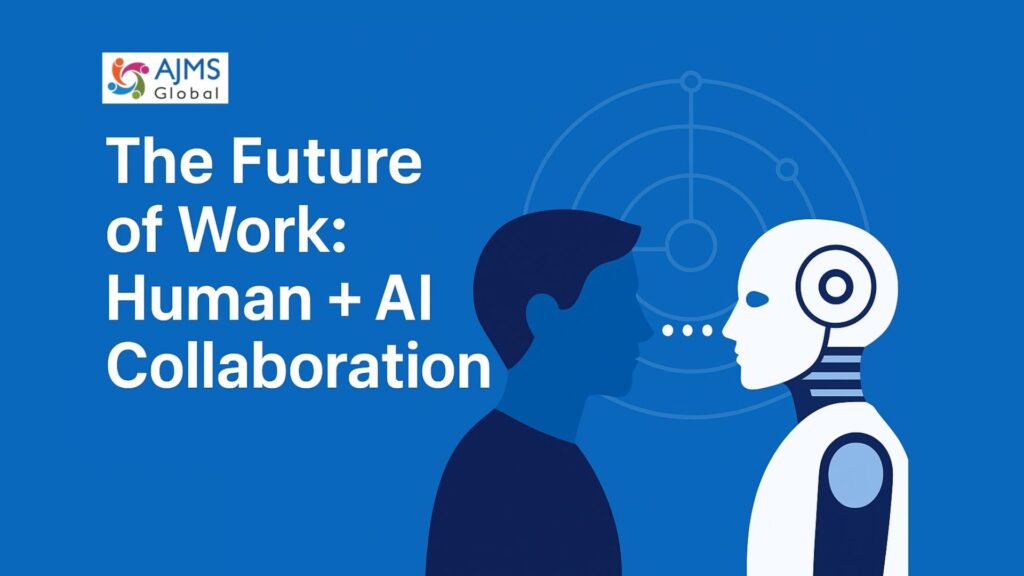In today’s rapidly evolving business landscape, the conversation around artificial intelligence has shifted from speculation to implementation. At AJMS Global, we recognize that the most forward-thinking organizations are no longer asking whether AI will transform their operations, but rather how to harness the synergy between human intelligence and machine capabilities to drive innovation and competitive advantage.
This fundamental shift represents one of the most significant opportunities for businesses to reimagine their approach to work, decision-making, and value creation. The strategic imperative is clear: companies that successfully integrate human expertise with AI capabilities are positioning themselves to outperform competitors who rely solely on traditional approaches or attempt to replace human insight with purely automated systems. At AJMS Global, we believe the key lies not in choosing between humans and machines, but in creating collaborative frameworks where each amplifies the other’s strengths.
Table of Contents
ToggleThe Strategic Foundation of Human-AI Synergy
Modern enterprises are discovering that the most powerful applications of AI emerge when machine learning algorithms work in concert with human intuition, creativity, and contextual understanding. This collaboration transcends traditional automation by creating intelligent systems that combine AI’s analytical processing power with human judgment, emotional intelligence, and strategic thinking.
Machine Learning Complementing Human Intuition
The relationship between algorithmic analysis and human insight represents a paradigm shift in how organizations approach complex challenges. While AI excels at processing vast datasets, identifying patterns, and generating predictions at scale, human professionals bring critical capabilities that remain irreplaceable: contextual understanding, ethical reasoning, creative problem-solving, and the ability to navigate nuanced situations that require empathy and cultural sensitivity.
In financial services, for example, AI systems can analyze millions of credit applications, identifying risk patterns and potential fraud indicators in real-time. However, human analysts provide the contextual judgment necessary to evaluate exceptional circumstances, understand the human stories behind the data, and make nuanced decisions that consider factors beyond algorithmic parameters. This collaboration results in more accurate risk assessments while maintaining the human touch essential for customer relationships.
Similarly, in healthcare environments, AI diagnostic tools can process medical imaging data with remarkable precision, identifying potential anomalies that might escape human detection. Yet, healthcare professionals bring the clinical experience, patient interaction skills, and holistic understanding necessary to interpret results within the broader context of patient care, medical history, and treatment options.
At AJMS Global, we encourage organizations to adopt such hybrid models, combining machine precision with human empathy to achieve optimal outcomes.
Real-World Applications: Where Collaboration Creates Value
Enhanced Decision-Making in Complex Environments
Leading organizations across industries are implementing human-AI collaboration frameworks that demonstrate measurable improvements in decision quality and operational efficiency. These implementations share common characteristics: they leverage AI’s computational advantages while preserving human oversight and judgment in critical decision points.
In manufacturing, companies like John Deere have revolutionized precision farming through AI systems that analyze satellite imagery, weather patterns, and soil conditions to provide real-time recommendations for irrigation, fertilization, and pest control. Rather than replacing agricultural expertise, these systems amplify farmer knowledge, enabling data-driven decisions that optimize crop yields while reducing environmental impact. Farmers maintain control over implementation strategies while benefiting from AI’s ability to process complex environmental data.
The retail sector offers another compelling example through Walmart’s AI-driven inventory management system. This technology analyzes sales trends, customer preferences, and supply chain dynamics to optimize stock levels across thousands of locations. However, human managers retain decision-making authority for local market considerations, seasonal variations, and strategic product positioning that require contextual understanding of customer behavior and competitive dynamics.
Customer Service Transformation
The customer service industry exemplifies the power of human-AI collaboration in creating superior customer experiences. AI-powered chatbots and virtual assistants handle routine inquiries, providing immediate responses to common questions while gathering customer information and context. When complex issues arise requiring empathy, creative problem-solving, or relationship management, the interaction seamlessly transitions to human agents who are equipped with comprehensive AI-generated insights about the customer’s history and needs.
This collaborative approach delivers multiple benefits: customers receive faster initial responses, human agents can focus on high-value interactions that require their unique skills, and organizations achieve higher customer satisfaction rates while optimizing resource allocation. Research indicates that companies implementing this hybrid model see up to 20% increases in customer satisfaction alongside significant improvements in agent productivity.
Navigating Implementation Challenges
Trust and Transparency
Successfully implementing human-AI collaboration requires addressing fundamental challenges related to trust, transparency, and organizational change. The most critical factor is ensuring that AI systems operate with sufficient transparency to enable human collaborators to understand, evaluate, and appropriately rely on machine-generated insights.
Organizations must invest in explainable AI technologies that provide clear reasoning behind recommendations and predictions. This transparency enables human professionals to make informed decisions about when to accept, modify, or override AI suggestions based on contextual factors and domain expertise that machines cannot fully comprehend.
Skill Development and Workforce Evolution
The transition to human-AI collaboration demands significant investment in workforce development and organizational learning. Rather than displacing human workers, successful implementations focus on augmenting human capabilities and creating new roles that leverage the unique strengths of both humans and machines.
This evolution requires comprehensive training programs that develop AI literacy among employees, helping them understand how to work effectively with intelligent systems. Organizations must also redesign workflows and processes to optimize the interaction between human judgment and machine capabilities, creating seamless collaborative experiences that enhance rather than complicate daily operations.
Ethical Considerations and Governance
Implementing human-AI collaboration frameworks requires robust ethical guidelines and governance structures. Organizations must address concerns about bias in AI systems, ensure fair and transparent decision-making processes, and maintain accountability for outcomes generated through human-AI partnerships.
This involves regular auditing of AI systems for bias and performance issues, establishing clear lines of responsibility for decisions made through collaborative processes, and implementing feedback mechanisms that enable continuous improvement of both human and machine performance within the partnership.
Conclusion: Leading the Transformation with AJMS Global
The future belongs to organizations that recognize human-AI collaboration not as a technological challenge to be solved, but as a strategic opportunity to be embraced. By thoughtfully integrating artificial intelligence with human expertise, companies can unlock new levels of performance, innovation, and competitive differentiation.
Success in this transformation requires leadership commitment to investing in both technology and people, creating cultures that value continuous learning and adaptation, and developing organizational capabilities that enable seamless collaboration between human intelligence and artificial intelligence.
At AJMS Global, we are committed to guiding organizations on this journey helping them leverage AI responsibly, enhance decision-making, and prepare their workforce for the future of work. The organizations that lead in this new era will be those that understand a fundamental truth: the most powerful business solutions emerge not from choosing between human creativity and machine efficiency, but from creating partnerships that combine both into something greater than either could achieve alone.
This is the essence of strategic human-AI collaboration and it represents the defining competitive advantage of our time.

